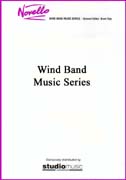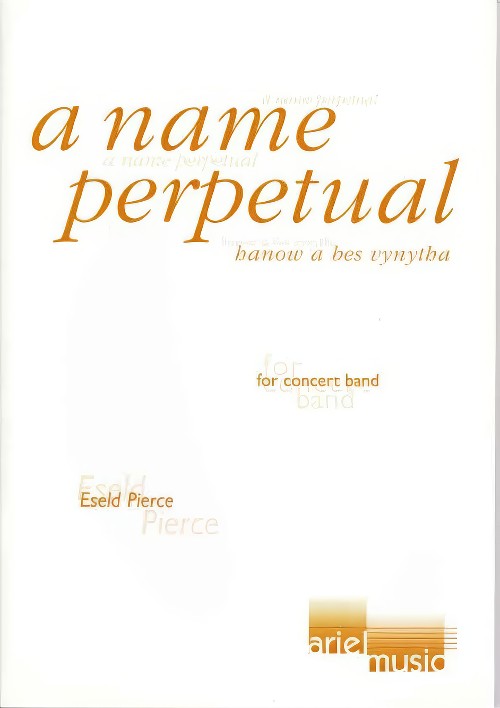Results
-
 £59.40
£59.40For thy Courts Above
An expressive fantasy based on the hymn, "Come, Thou Fount of Every Blessing". Huckeby's sonorous and richly harmonized setting is an excellent vehicle for expanding your band's ability to perform in a warm legato style while gaining an eloquent program piece. A truly impressive and moving work!
Estimated dispatch 7-14 working days
-
 £77.22
£77.22Force of Destiny
Commissioned in honor of a beloved band director who passed away at too young an age, Force of Destiny is a bold, beautiful, and upbeat celebration of the meaning of life and the pursuit of one's destiny. A gentle introduction leads to up-tempo themes that are alternately martial and lyrical. The delicate middle section, which builds to a powerful climax, provides an expressive showcase for your band. A strong restatement of the opening theme powers to a bold and dramatic finish. The variety of themes, tempos, colors, and expressions in this piece make it ideal for contest or competition, and an excellent way to showcase the subtly and power of your ensemble.
Estimated dispatch 7-14 working days
-
 £214.95
£214.95JOURNEY THROUGH A JAPANESE LANDSCAPE (Percussion Solo with Concert Band - Score and Parts) - Musgrave, Thea
Concerto for Solo Marimba and Wind Orchestra. The four movements of Journey through a Japanese Landscape are based on a series of haiku which represents an emotional journey through the four seasons. The three haiku chosen for each of the seasons provide a setting and an event; thus, the gently undulating spring sea is the background for the free, improvisatory character of the skylark. The summer grasses have buried the glorious dreams of ancient warriors and after a violent storm, a distant memory of a march is heard. An autumnal fog envelops a colossal Buddha and a lonely watcher sounds one gong after another while a cricket acts as a grave keeper. Glass wind chimes introduce the frozen winter landscape. The march returns, then sleet and snow build to a big storm. Out of the silence that follows, echoes of the first movement suggest the return of spring and so, rebirth. (Grade 4) Duration: 23:00
Estimated dispatch 7-14 working days
-
 £49.95
£49.95JOURNEY THROUGH A JAPANESE LANDSCAPE (Percussion Solo with Concert Band - Score only) - Musgrave, Thea
Concerto for Solo Marimba and Wind Orchestra. The four movements of Journey through a Japanese Landscape are based on a series of haiku which represents an emotional journey through the four seasons. The three haiku chosen for each of the seasons provide a setting and an event; thus, the gently undulating spring sea is the background for the free, improvisatory character of the skylark. The summer grasses have buried the glorious dreams of ancient warriors and after a violent storm, a distant memory of a march is heard. An autumnal fog envelops a colossal Buddha and a lonely watcher sounds one gong after another while a cricket acts as a grave keeper. Glass wind chimes introduce the frozen winter landscape. The march returns, then sleet and snow build to a big storm. Out of the silence that follows, echoes of the first movement suggest the return of spring and so, rebirth. (Grade 4) Duration: 23:00
Estimated dispatch 7-14 working days
-
 £84.99
£84.99JOY (from Awakening) (Concert Band) - Curalie, Joseph
This positively overflows with joy! An outstanding work - very worthy of your consideration. Interesting metrical shifts, bold statements, and well-placed playful motives add up to an overall creative musical experience. Elements of an "American" sound harkens to the music of Copland, yet is found here distinctly fresh and new. Taken from Curiale's orchestral work Awakening, with the optional harp part included. Highly recommended! Grade: Medium/Advanced
Estimated dispatch 7-14 working days
-
 £224.99
£224.99Les Marteaux de la Marine Wind Band Set (Score & Parts)
Les Marteaux de La Marine was composed in 1999 as a commission by the Marine Band of the Royal Netherlands Navy. The composition contains three static elements which interchange. Static in this case means that development of the material is not pursued (by the composer). The first element with which the piece begins is tranquil and colourful. The second element is sharp and incisive, while the third expresses energy. In all elements a repeated tone is the starting point which explains the hammers in the works title.The instrumentation is richly variegated with a harp also determining the palette of colours in the slower movements. The composition opens with an atmospheric Larghetto containing fine harmonies in the soft and subtly moving wood-winds. The introduction breathes an impressionistic atmosphere in which expressive cantilenas and soloistic agile motifs stand out. A strong setting is followed by an Allegro virtuoso containing fast motifs contrasted with short and rhythmic stars of the various instrumental sections. Trumpets and horns add a virtuoso bugle-call motif. After a short stringendosection, the transparent Larghetto returns with a varied setting of the opening elements. The beautiful leading roles in this section are reserved for cornet (trumpet) and horn. Subsequently, the flashing Vivo starts with continuous movements in triplets from both wood-winds and brass. Next, the opening Allegro re-appears once again and thus Les Marteaux de la Marine ends with a fast and virtuoso climax. Les Marteaux de La Marine was selected as a compulsory grade 6 contest piece for symphonic bands in the Netherlands. 17:45
Estimated dispatch 7-14 working days
-
 £76.99
£76.99Little Red Monkey Wind Band Set (Score & Parts)
Solo for Baritone Saxophone or Eb Bass with high humorous content. The soloist tries in an entertaining dialogue with the orchestra to prevail. During the work, in a musical way, appears an conflict with the xylophone, the orchestra makes an end to the debate with a melodious final chord. A must for your concert! 02:15
Estimated dispatch 7-14 working days
-
 £115.00
£115.00NAME PERPETUAL, A (Concert Band) - Pierce, Eseld
Under the leadership of Michael An Gof and Thomas Flamanck, a Cornish host, sometimes estimated to number as many as 15,000, marched to London in protest against excessive taxation. Arriving at Blackheath, they were attacked by the King's army and defeated, and the two rebel leaders were hung, drawn and quartered. On his way to his death, An Gof stated that he would have "a name perpetual and a fame permanent and immortal". A Name Perpetual tells the story of the Rebellion in four connected scenes. The music includes strong elements of the Celtic music tradition, being structured around an old Cornish folk tune. The first scene introduces fragments of the folk theme and reflects the anguish of the Cornish people. The second scene opens with the folk theme on solo piccolo and, as different instruments enter one by one, the march is depicted with its accumulation of forces en route. The march halts suddenly as the Cornishmen discover the unexpected arrival of the English army and the subsequent music portrays the Blackheath Skirmish. In this scene the orchestra is divided into four parts, each working independently to create a sense of chaos, with the stronger elements of the brass and bass instruments representing the English, while the woodwind and saxophones represent the Cornish, struggling to sustain the folk tune throughout the battle. Eventually all the parts come together and the final section is a lament for the lost Cornishmen, fading away to leave only a haunting off-stage trumpet solo.
Estimated dispatch 7-14 working days
-
 £37.62
£37.62Old Glory (Concert Band - Score and Parts)
An exciting rock tune that includes an optional section where you can give any of your students a chance to play an improvised solo. Includes parts for Keyboard, Electric Bass and Drum Set and solo sheets to help your young players understand the chords and scales to the solo section. A perfect way to introduce improvisation to all of your students!
Estimated dispatch 7-14 working days
-
 £39.60
£39.60Pachyderm Peanut Posse (Concert Band - Score and Parts)
A delightful tune for very young players at an "Ellaphante" tempo. Very easy since horn parts consist only of quarter, half and whole notes. Percussion includes parts for snare and bass drums plus an easy part for tom-toms and a slightly more difficult wood block part. A great way to present your youngest students in a very positive light and sure to be an audience favorite!
Estimated dispatch 7-14 working days
